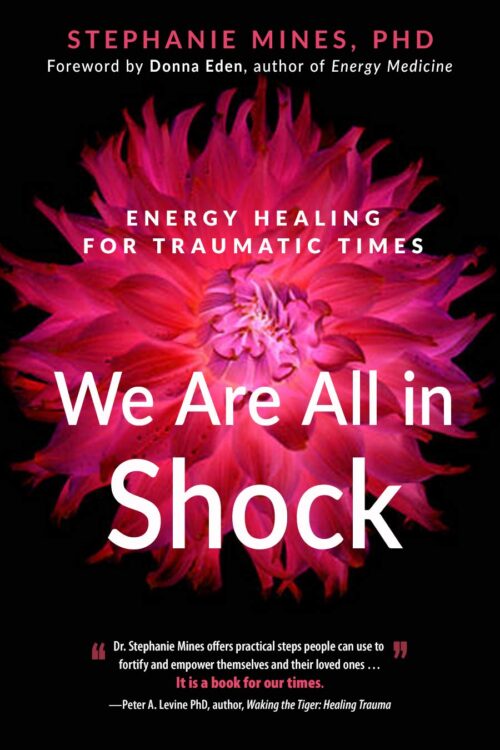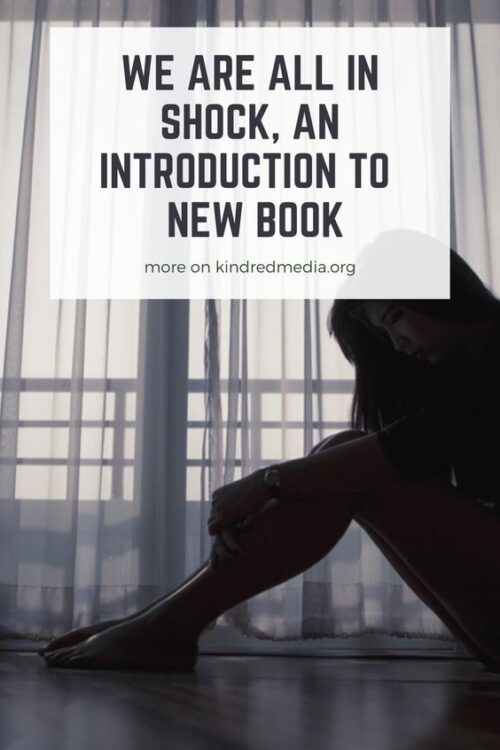We Can Heal The Shock We Carry: 10 Steps To Resolving Shock
Unresolved shock can keep us from our full potential.
We are all in shock. The most recent set of shocks come from physical isolation and distancing from loved ones, fear-based media messages, economic distress, racism in policing and medicine. Most of the time, we don’t know what to do to resolve shock and end up living less fully as a result. Even before shock experiences in adulthood, many of us have unresolved shock from birth and early life phases.
The timing of Stephanie Mines’ new edition of her book, We Are All in Shock: Energy Healing for Traumatic Times, could not be better. She guides readers in self-healing through an integration of trauma psychology, neuroscience, and energy medicine. Energy medicine is attuned to the body’s natural healing responses.
What is shock?
Although the consensus on definitions is in flux, Mines distinguishes shock from trauma: Shock is global whereas trauma is specific. Shock is extreme, severe trauma. In her book she describes major and minor shock, early life shock, immediate, conditioned and residual shock. She teaches the reader how to recognize it in our own behavior.
What happens in shock?
When the shocking experience occurs, the body’s primitive survival systems get activated to keep us alive. But they also engrave the body-mind with a memory that conditions our future responses to similar situations.
Mines explains the physiology of the brain, stress response and central nervous system. She discusses the two basic forms of shock that must be distinguished because they display differently: Sympathetic and parasympathetic shock.
Sympathetic response mobilizes the body with increased heart rate and metabolism which is useful under actual threat. But, for example, if overwhelming experiences occur before we can consciously regulate them (in early life), the result is sympathetic shock. It is visible in hyperactivity, hypervigilance and a resistance to resting.
Parasympathetic shock is the repression of the stress response, a learned response when mobilization did not bring relief and energy must be reserved to keep alive. Parasympathetic shock resembles depression with withdrawal, low vitality and inflammation. When it is triggered, individuals often feel disconnected, speechless, frozen and breathing shallowly.
Mines discusses the different forms of therapeutic intervention that should be taken by helpers for each type of shock.
Developmental Shock
“Neurological development is carefully sequenced. First one window of opportunity opens, then the next, and then another in a precise order wisely predetermined by nature. When a particular window (developmental sequence) is not fully opened (nurtured until completion), it remains in a limbo state, neither fully open nor fully closed. Shock is the culprit that prevents these windows from opening completely (Mines, 2020, p. 36).
In order to reopen developmental windows, attention, touch and stimulation to self or from others. Mines describes ways that adults can heal themselves from developmental shock. She also guides pregnant mothers on how to prevent shock, or resolve it quickly and thoroughly, to the fetus and infant.
How do we heal shock?
Using the Japanese approach to healing, Jin Shin, like one of her teachers, Peter Levine, she points out how shock gets lodged in the body. The book is sprinkled with lots of real life examples.
Each person can learn to recognize and resolve their shock experience, sometimes alone, other times with help. Mines’ goal is to empower the reader to clear out the conditioning that decreases our freedom to live with buoyancy. Mines describes ten steps to resolving shock.
- Identify the lesson in the overwhelming experience.
- Sustain this awareness.
- Establish a strong relationship with your body.
- Develop an inner witness.
- Make a bond with nature.
- Know that laughter is the best medicine.
- Use language as a healing tool.
- Use touch to heal.
- Separate past from present.
- Address shock immediately.
A consistent message throughout the book is the importance of self-love, not only through the energy healing of touch but positive self-talk. Instead of being self-judgmental, which can perpetuate shock and trauma, Mines suggests taking a position as a witness to the primitive brain’s reactions to situations—the times you get agitated or suddenly numb for no apparent reason. These are conditioned shock responses. Developing a loving inner witness to the self-talk and reactivity is the first step to identify particular ‘recordings’ brought from the past into the future. Mindful self-kindness helps one realize that one does not have to believe one’s thoughts. A compassionate inner witness will identify the true origins of a behavior and instigate the power to change. Her techniques offer ways to consciously heal such habitual reactions.
The approach for energy medicine is self-mentoring toward healing old shocks and manage ongoing stress. One must learn to identify the energy pulses and energy centers in the body to rebalance the self. She provides step by step learning of self-attunement.
“Resolving shock with energy medicine is like weaving with energy or orchestrating inaudible, yet exquisite, music. Think of your hands as the instruments that link your mind and body, your past and present, your personality and spirit, and your heart and soul” (Mines, 2020, p. 101).
Helping Others Heal Shock
Therapists and friends can help others build their inner resources. All along the way, reinforce the positive resources that are revealed.
- Ask how they were able to survive the shock and trauma?
- Notice when a person brightens up as a signal of a source of strength that can be cultivated.
- Suggest that the resource(s) be used whenever shock is triggered. Making a list of the resources and posting them can be helpful.
- Tell trusted friends about the resources and ask them for reminders.
- Make constructing resources as a life goal.
Parents are advised to know the difference between sympathetic and parasympathetic activation in their children and to use the tools for each, use appropriate physical contact when speaking to the child, and seek to perceive the whole picture (the messages behind a behavior). And, parents should reflect about their own reactions.
Ongoing Shock from Climate Instability
The climate is unstable and bringing extreme weather. This book addresses how climate shock interrupts normal endocrine responses to threat, requiring the level of intervention that Mines’ book provides. “Given the conditions of shock caused by environmental disaster, self-care may be the most important tool for any individual, family or community” (Mines, personal communication).
Conclusion
The book has healing practices for all sorts of issues, such as anger, fear, fatigue, sugar craving and inattention. Stephanie Mines’ work with body energy reminds me of Brain Gym, which was developed to help classroom children re-energize through specific positions and pressure on different parts of the body. It prepares them to focus and learn better.
Reference
Mines, S. (2020). We are all in shock: Energy healing for traumatic times. Newburyport, MA: New Page.



